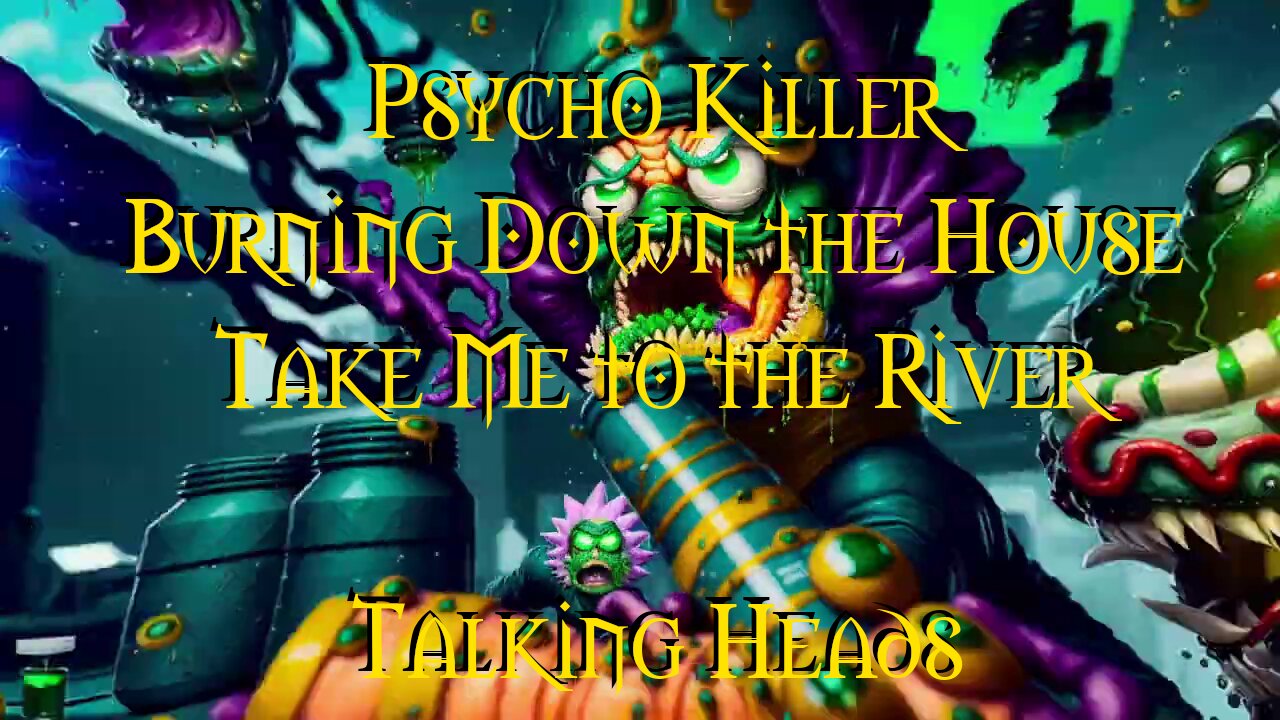Premium Only Content

Psycho Killer Burning Down The House Take Me To The River Talking Heads
Psycho Killer, Burning Down The House and Take Me To The River by the Talking Heads
Rick Sanchez recommends remembering your zip code when going on a trip...
Talking Heads '77 Psycho Killer
It started when lead singer David Byrne decided to write something in the vein of Alice Cooper, whose shock rock was all the rage. Byrne started with the first verse, which establishes a dangerous paranoia:
I can't seem to face up to the facts
I'm tense and nervous and I can't relax
I can't sleep 'cause my bed's on fire
Don't touch me I'm a real live wire
The rest of the lyric is even more capricious, with this guy admitting he's a psycho killer and warning us to run. It ended up being far more introspective than most Alice Cooper songs, but just as believable: while Cooper is a completely different guy off stage (Vince Furnier), Byrne really is the socially awkward genius he portrays in performance. He's never killed anyone (that we know of) but can convincingly inhabit the character.
This was the first Talking Heads song. It was written in 1973 at the Rhode Island School of Design (RISD), where David Byrne and drummer Chris Frantz had a band called The Artistics. When Byrne presented the song, he explained that he wanted a Japanese section in the bridge, but when he asked a girl who spoke the language to come up with some murderous words, she understandably freaked out. Frantz' girlfriend, Tina Weymouth, spoke French, so they had her write a French part for the bridge instead. She drew inspiration from the Norman Bates character in the 1960 Alfred Hitchcock thriller Psycho, which influenced the next verse:
You start a conversation you can't even finish it
You're talking a lot, but you're not saying anything
When I have nothing to say, my lips are sealed
Say something once, why say it again?
Byrne incorporated a French line into the chorus: "Qu'est-ce que c'est?" (meaning "What is this?") and followed it with a stuttering warning:
Fa-fa-fa-fa-fa-fa-fa-fa-fa-far better
Run, run, run, run, run, run, run away
The end result is one of the most famous songs about a psychopathic murderer, influenced by two touchstones of the genre: Alice Cooper and the movie Psycho.
The French section in the Bridge roughly translates to:
What I did that night
What she said that night
Realizing my hopes
I launch myself towards a glorious destiny
This reveals that the psycho killer is targeting a woman, just as Norman Bates did in Psycho.
Credited to David Byrne, Chris Frantz and Tina Weymouth, this is the only song on the Talking Heads' debut album that isn't listed as a solo Byrne composition. Songwriting credits quickly became a sticking point in the band as Byrne became the focal point and gave the impression that he did all the songwriting himself. Frantz claims that he wrote the second verse to "Psycho Killer," but Byrne has downplayed his contribution to the song, telling Mojo, "Chris and Tina helped me with some of the French stuff."
The "fa fa fa" part is redolent of the Otis Redding song "Fa-Fa-Fa-Fa-Fa (Sad Song)." Redding and other soul singers were a big influence on Talking Heads.
There really was a psycho killer on the loose in the summer of 1977, months before this song was released. David Berkowitz, the "Son of Sam," terrified New Yorkers before he was caught on August 10 after killing six people. Many suspected the song was about him, but it was written much earlier.
Album: Speaking In Tongues (1983) Burning Down The House
Talking Heads drummer Chris Frantz and bass player Tina Weymouth, married since 1977, are big fans of funk. When they went to a P-Funk show at Madison Square Garden in New York City, the crowd started chanting, "Burn down the house, burn down the house" (this is before "The Roof Is on Fire"), which gave Frantz the idea for the title.
With a lot of help from MTV, who gave the video a lot of play, this song became Talking Heads' biggest hit. It didn't get a great deal of radio play at the time, but has endured as an '80s classic and is often used in movies and TV shows, including Gilmore Girls, 13 Going on 30, Six Feet Under, Revenge of the Nerds and Someone Like You.
The French keyboard player Wally Badarou, known for his work with Grace Jones and Level 42, overdubbed the synthesizer parts on this track, a key addition. Percussionist Steve Scales contributed concert toms to the song.
Album: More Songs About Buildings and Food (1978)
Take Me To The River
Written by Al Green with his guitarist, Teenie Hodges, "Take Me To The River" first appeared on Green's 1974 album Al Green Explores Your Mind. It wasn't a hit, but attracted lots of cover versions, including by Syl Johnson in 1975, Foghat in 1976 and Bryan Ferry in 1978.
Green and Johnson's versions were well known in R&B circles, but the Talking Heads brought it to the New Wave rock crowd and had the highest charting version of the song, reaching #26 in the US.
The song is about a baptism, a topic that jelled with Al Green, who later became an ordained minister. You wouldn't think a New York City-based art-rock band could pull off a gospel-tinged song by a Southern soul singer, but Talking Heads kept the spiritual feel of the song while putting their own spin on it - lead singer David Byrne doesn't sound like a traditional vocalist and could inhabit a character quite believably. His version of preaching on "Take Me To The River" foreshadowed a later Talking Heads hit, "Once In A Lifetime."
A track from Talking Heads' second album, More Songs About Buildings And Food, "Take Me To The River" was their biggest hit to this point and the only single from the album. It earned them a spot on American Bandstand, getting them on national TV for the first time. The group didn't strive for hits and didn't rack up huge sales numbers, but they pushed musical boundaries throughout their career to end up with a very impressive discography that landed them in the Rock and Roll Hall of Fame in 2002.
The More Songs About Buildings And Food album was one of the first recorded at Compass Point Studios in Nassau, Bahamas. The studio was set up by Island Records owner Chris Blackwell, who cut the Talking Heads a deal because he needed to get some big acts in there to establish it. According to Talking Heads drummer Chris Frantz, Blackwell ringed the perimeter of the grounds with chicken blood to keep evil spirits away. This voodoo worked: The band had a great experience at Compass Point and recorded their next two albums there.
-
 4:20
4:20
Psychological operations
9 days agoElectric Eye Judas Priest
371 -
 1:12:22
1:12:22
Side Scrollers Podcast
13 hours agoThe Real Game Awards: Official Live Stream
96.1K15 -
 59:48
59:48
The StoneZONE with Roger Stone
7 hours agoJanuary 6 Victim Jeremy Brown Still in Jail Despite Trump Pardon | The StoneZONE w/ Roger Stone
58.1K11 -
 1:45:44
1:45:44
megimu32
8 hours agoON THE SUBJECT: Make 90s Movies Great Again
46.5K10 -
 59:46
59:46
Man in America
14 hours agoAI mRNA Vaccines, Turbo Cancer & Blood Clots... What Could Go Wrong?! w/ Tom Haviland
41.6K26 -
 1:09:15
1:09:15
Precision Rifle Network
1 day agoS4E3 Guns & Grub - Trump a new era for gun rights?
80.6K9 -
 1:05:31
1:05:31
Glenn Greenwald
10 hours agoSection 702 Warrantless Surveillance Ruled Unconstitutional: Press Freedom Advocate Seth Stern Explains; The Rise of Unions & the Impact of Trump's Populism with Author Eric Blanc | SYSTEM UPDATE #395
112K96 -
 1:01:13
1:01:13
The Amber May Show
8 hours ago $3.64 earnedWomen Of Rumble | Amber, Kelly and Wendy Wild
48.4K4 -
 1:16:38
1:16:38
Josh Pate's College Football Show
10 hours ago $2.30 earnedCFP Title Viewership | JP Poll Under Attack | Bama & Oregon Season Grades | Most To Prove In 2025?
46.7K -
 5:10:59
5:10:59
VOPUSARADIO
14 hours agoPOLITI-SHOCK! "THE TIDE IS TURNING"! 3 SPECIAL GUESTS JOINING US TONIGHT!
31K2